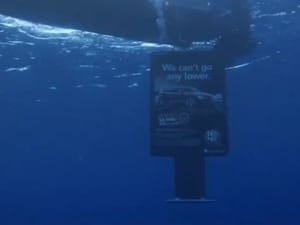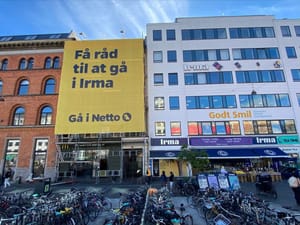Have you seen Duval Guillaume’s latest ad for Alfa Romeo yet? In it, they show a filmed story of how they lower a poster to the lowest point on earth (which it isn’t by the way), to make a point about low prices. Oh, hardy-har, isn’t that clever. No. It’s a long way for a drink of water, and the only way it’ll spread (as the agency hopes, I’m sure) is if the punters believe that they actually did this. Watch the film.
Alfa Romeo – Expedition 147: Alfa Romeo advertises on lowest point on earth.
At 01:51 they leave what seems to be a pretty big clue, to let some folks in on the joke: “It’ll be crushed before it reaches the bottom” says a man who knows about pressure. Then they spend some time elaborating on how the special billboard is filled with water and such to avoid this faith. But honestly, do you really think they put a billboard at that depth, when all they had to do was make a cute film somewhere tropical instead (way cheaper). Not to be a bore, but environmental agencies tend to really dislike advertisers tossing billboards all over the landscape. (I recall some soda-pop brand fined lots of money for painting a mountain somewhere years ago, but I can’t find my old adland post about it now.) Agencyspy even posted the question: Is Alfa Romeo’s latest campaign a fake?
I’ve been a bit wary of this particular Belgian agency ever since the Schweppes fountains of effervescence. Their release, which Caff caught first and posted stated: “… fountains through European cities in countries such as Germany, Switzerland, Sweden and Norway” – a really random collection of countries (and no cities actually named) coupled with a bunch of large photos that could just as well be photoshopped. Is it Hoaxvertising, as I coined it in the 10*10 – top ten new ad spaces in the past ten years, or did they actually do it? When asked them point blank, they kinda dodged me. Other works from them could clearly be done, like the bowling hole stickers, and then the question only is how many stickers did they actually distribute? Does it matter, when every newspaper and blogs picks up on the story? Not really, they reach the eyeballs they might have missed on the street, via those who talk about it. And that is the idea of “hoaxvertising”.
Just look at the success of the largest drawing in the world, where the student project shown had one part GPS, one part DHL and one part gusto. Stir, mix, make a credible film and toss it up on youtube and bingo – the world was talking about the idea. Erik Nordenankar who made it later clarified with bright red text on his project page that “This is my graduation project on advertising and graphic design at Beckmans college of design. This is fictional work. DHL did not transport the GPS at any time”. Which was fine, since it still kicked ass as a graduation project.
Now that he’s working at Mother though, and is the guy on the left in The Honest Christmas Spam film, one might start to wonder if this film is a real as it portrays to be. Wouldn’t that be funny, if it was set up? I mean, with the name “honest” in the film and all. The conversation might have gone “Hey, Theo Delaney, wanna look like a hero and play a part in our christmas card idea? We’re going to give ten grand to Forward Nigeria and thought you’d be the right guy to help tell the story.”
Then again, nobody actually expects advertising to be honest now, do they? That’s like expecting reality TV to be unscripted.




